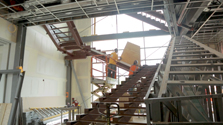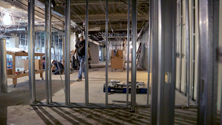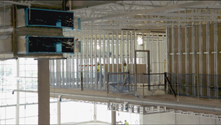Guest Column: Inflation’s Looming Impact on Construction
The inflation rate has been so low for so long that some businesspeople may assume it won’t be a major factor going forward. They could be wrong, warn Leopardo Cos.' Pierre Cowart and Rory Tihinen.
 By Pierre Cowart and Rory Tihinen
By Pierre Cowart and Rory Tihinen
The inflation rate has been so low for so long that some businesspeople may assume it won’t be a major factor going forward. They could be wrong. The inflation rate is likely to rise, and that will have a significant impact on the cost of commercial construction. Even a 2.5 percent increase in annual inflation could add 10 percent or more to a project’s cost. Thus, companies considering future projects are advised to act quickly, look for ways to shorten the development cycle, and find a contractor that can minimize the risks associated with rising inflation.
The inflation rate is calculated from the U.S. Bureau of Labor Statistics’ Consumer Price Index (CPI), which measures changes in the price of a cross-section of urban consumer goods and services. The highest annual inflation rate during the past 10 years occurred in 2008, when it measured 4.1 percent; the lowest was in 2009, when it stood at 0.1 percent. But excluding that tumultuous time, rates have ranged from a high of 3.4 percent to a low of 1.5 percent. Inflation was just 1.7 percent in 2012, and the annualized rate was just 1.5 percent in the early months of 2013.
 Going forward, low inflation is not a sure thing. As unemployment inches downward, there is upward pressure on wages and prices. Improving the labor market is a key goal for the Federal Reserve, which started a program in September 2012 to buy $85 billion in mortgage-backed securities and Treasuries each month.
Going forward, low inflation is not a sure thing. As unemployment inches downward, there is upward pressure on wages and prices. Improving the labor market is a key goal for the Federal Reserve, which started a program in September 2012 to buy $85 billion in mortgage-backed securities and Treasuries each month.
That program could lead to unwanted levels of inflation over the long term, according to comments in April by Richard Fisher, president of the Federal Reserve Bank of Dallas. Earlier this year, Fed presidents in Philadelphia and St. Louis also expressed concern that the current low-interest-rate environment may push inflation higher than desired.
None of these experts appears to be predicting a return to the double-digit inflation rates of the 1970s and 1980s. Over the past three decades, inflation has rarely exceeded 5 percent, and the Fed has indicated it would continue its buying program only as long as inflation remained “in check.”
Impact on Real Estate
 But the effects of inflation tend to be magnified when it comes to the development process. As a rule of thumb, 2 percent inflation equates to a 4 percent increase in the price of construction materials. That’s because material prices are based on the Producer Price Index (PPI), a measure of the price of manufactured goods, which is typically double the core CPI.
But the effects of inflation tend to be magnified when it comes to the development process. As a rule of thumb, 2 percent inflation equates to a 4 percent increase in the price of construction materials. That’s because material prices are based on the Producer Price Index (PPI), a measure of the price of manufactured goods, which is typically double the core CPI.
Construction labor costs rise faster during periods of higher inflation, as well. Most construction work in Illinois, for instance, is based on three-year union contracts, with about one-third of contracts expiring every year. Over the course of a three-year project, virtually all of the subcontractors involved will go through a round of union negotiations over wages and benefits. The faster consumer prices are rising, the harder unions will push for compensation levels that keep pace with the cost curve—or even get ahead of it, if possible.
The unpredictability of material and labor prices is one of the trickiest parts of construction cost budgeting, and it becomes even more difficult in a period of uncertain inflation. The challenge lies in the lag time between the design phase and the purchase of materials. Zoning and preconstruction processes on major projects typically require eight to 12 months or more before construction can start, and the construction phase can take another 12 to 24 months. Materials and labor are purchased throughout the construction phase, sometimes as much as three years after the plans were budgeted and approved.
So if you were to budget a project based on 1.5 percent projected inflation over three years and inflation were closer to 3.5 percent, the 2 percent difference would add 4 percent to the cost of construction materials bought in the first year, potentially another 4 percent the following year, and so on. Your budget could be off by 10 percent or more.

A good rule to hedge inflation is to escalate pricing through the mid-point of the intended construction duration. But the real lesson here is not about budgeting; it’s about taking action. Every year that a project is delayed adds to the construction cost, and the rare combination of low interest rates and low inflation rates will not be around forever. Companies that can start the process now have the best chance of avoiding the worst effects of higher inflation in the future.
Fast-Tracking Projects
In addition to starting sooner, developers can minimize the risk of economic uncertainty by moving through the development process quickly. The best way to fast-track a construction process is to get the contractor involved as early in the process as possible.
Even if inflation were not a factor, the ability to complete a project quickly should be a goal: It saves money on the debt service and allows the facility to become a revenue generator sooner. Integrating the design and construction teams at the outset of the project can reduce costs by overlapping the two phases of development, which traditionally have been sequential.
 Furthermore, when the contractor is involved in the design phase, it creates an opportunity to start preconstruction while design features are still under consideration. Typically, a building’s footprint and the location of site elements such as parking and retention ponds are determined before the design phase is complete. Zoning and site work can begin on those elements before the HVAC systems and interior finishes are specified. With an experienced team, the preconstruction phase can be very far along by the time designs are complete, shortening the development cycle by six months or more.
Furthermore, when the contractor is involved in the design phase, it creates an opportunity to start preconstruction while design features are still under consideration. Typically, a building’s footprint and the location of site elements such as parking and retention ponds are determined before the design phase is complete. Zoning and site work can begin on those elements before the HVAC systems and interior finishes are specified. With an experienced team, the preconstruction phase can be very far along by the time designs are complete, shortening the development cycle by six months or more.
Including the contractor in design decisions also allows them to order construction materials early enough to avoid delays. Steel and precast concrete both require several months for delivery. Once the size and general layout of the building are determined, the contractor can calculate how much is needed and place the order so it arrives in time to keep the process moving forward.
Other products that must be ordered in advance—components of HVAC systems, for example—may not be determined until the end of the design phase, but these materials may not be needed on site in the early stages of construction.
Development teams can further reduce the construction timeframe through use of Building Information Modeling (BIM), a digital technology that creates three-dimensional blueprints and shares them across the design, construction and eventually facilities management phases of the building’s life cycle. The use of BIM also helps to reduce construction timeframes and avoid weaknesses in the design that otherwise might not be caught until construction is underway.
Choosing a Construction Partner
Besides fast-tracking projects, another way to blunt the effects of inflation is to use the contractor’s savvy to minimize the cost of materials. For example, larger contractors with more jobs in the pipeline may use their power-buying muscle and supplier relationships to negotiate lower material pricing and/or faster delivery.
An experienced contractor should also be able to demonstrate an understanding of acceptable substitute materials if products specified during design turn out to be more expensive than anticipated or are not available in time to keep the project on schedule.
Contractors employ experts to estimate the cost of projects, and the impact of inflation is typically part of that calculation. The uncertainty of future inflation is ultimately the risk that the owner takes on, as the contract language assumes a certain level of price increase but absolves the contractor from liability if prices skyrocket unexpectedly. So in an uncertain economic climate, it is important for a company to work with a contractor that understands commodities pricing and can provide advice on mitigating the risk of inflation. That may involve making an upfront investment that acts as a hedge against over-standard inflation, such that the company pays a little more to avoid the risk of paying a lot more if inflation rises sharply.
By acting as quickly as possible to lock in historically low interest rates, integrating the design-development efforts and ensuring use of experienced contractors, developers pursuing new construction or renovation can hedge significantly again inflation risk. And the sooner they start the process, the better their chances of gaining a competitive advantage for years to come.
Pierre Cowart is a senior vice president and Rory Tihinen is a vice president at Leopardo Cos. (www.leopardo.com), one of the nation’s largest construction firms, with industry-leading estimating and preconstruction services. Leopardo frequently plays the role of economic strategist on construction projects, providing counsel on material price fluctuations, supply-demand fundamentals, alternative methods of construction, lifetime costs and overall project efficiencies.






You must be logged in to post a comment.